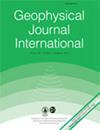Nonlinear seismic response analysis of slopes considering the coupled effect of slope geometry and soil stratigraphy
IF 2.8
3区 地球科学
Q2 GEOCHEMISTRY & GEOPHYSICS
引用次数: 0
Abstract
Summary To investigate the effects of slope geometric parameters and soil stratigraphic properties on the topographic amplification of ground motions, a large number of 2D horizontally layered slope models are constructed. Firstly, the linear and nonlinear seismic responses of a slope model are compared, and the result shows that the nonlinear characteristics of soils should be considered when studying the amplifying effect of slope topography on ground motions. Then, the nonlinear seismic responses of these slope models are analyzed from four aspects: the maximum shear strain in the slopes, the effects of geometry and stratigraphy on the seismic response, the distance between the maximum topographic amplification indicators and the slope crest, and the influence range of slope topography behind the slope crest. The results indicate that the amplifying effect of slope topography on ground motions increases with increasing slope height or decreasing average shear-wave velocity of the overlying soil layers. Besides, the variation of the topographic amplification effect with slope gradient is significantly influenced by soil stratigraphic properties. The distance between the maximum topographic amplification indicators and the slope crest is mainly in the range of 0 ∼ 60 m, and the influence range of slope topography behind the slope crest is mainly in the range of 0 ∼ 150 m. Subsequently, approximate relations are derived based on regression analyses of simulation results, which can provide meaningful references for the seismic design and seismic retrofitting of engineering structures behind the slope crest. Finally, the effects of slope geometric parameters and soil stratigraphic properties on ground motion modifications are further evaluated according to the prediction curves provided by the approximate relations.考虑斜坡几何形状和土壤地层耦合效应的斜坡非线性地震响应分析
摘要 为研究边坡几何参数和土层性质对地震动地形放大作用的影响,建立了大量二维水平分层边坡模型。首先,比较了斜坡模型的线性和非线性地震响应,结果表明在研究斜坡地形对地面运动的放大效应时,应考虑土壤的非线性特征。然后,从斜坡最大剪切应变、几何和地层对地震响应的影响、最大地形放大指标与坡顶的距离以及坡顶后斜坡地形的影响范围四个方面分析了这些斜坡模型的非线性地震响应。结果表明,边坡地形对地面运动的放大效应随着边坡高度的增加或上覆土层平均剪切波速的减小而增加。此外,地形放大效应随坡度的变化还受到土壤地层性质的显著影响。最大地形放大指标与坡顶之间的距离主要在 0 ~ 60 m 范围内,坡顶后边坡地形的影响范围主要在 0 ~ 150 m 范围内,根据模拟结果的回归分析得出近似关系,可为坡顶后工程结构的抗震设计和抗震改造提供有意义的参考。最后,根据近似关系提供的预测曲线,进一步评估了斜坡几何参数和土壤地层特性对地面运动修正的影响。
本文章由计算机程序翻译,如有差异,请以英文原文为准。
求助全文
约1分钟内获得全文
求助全文
来源期刊

Geophysical Journal International
地学-地球化学与地球物理
CiteScore
5.40
自引率
10.70%
发文量
436
审稿时长
3.3 months
期刊介绍:
Geophysical Journal International publishes top quality research papers, express letters, invited review papers and book reviews on all aspects of theoretical, computational, applied and observational geophysics.
文献相关原料
| 公司名称 | 产品信息 | 采购帮参考价格 |
|---|
 求助内容:
求助内容: 应助结果提醒方式:
应助结果提醒方式:


